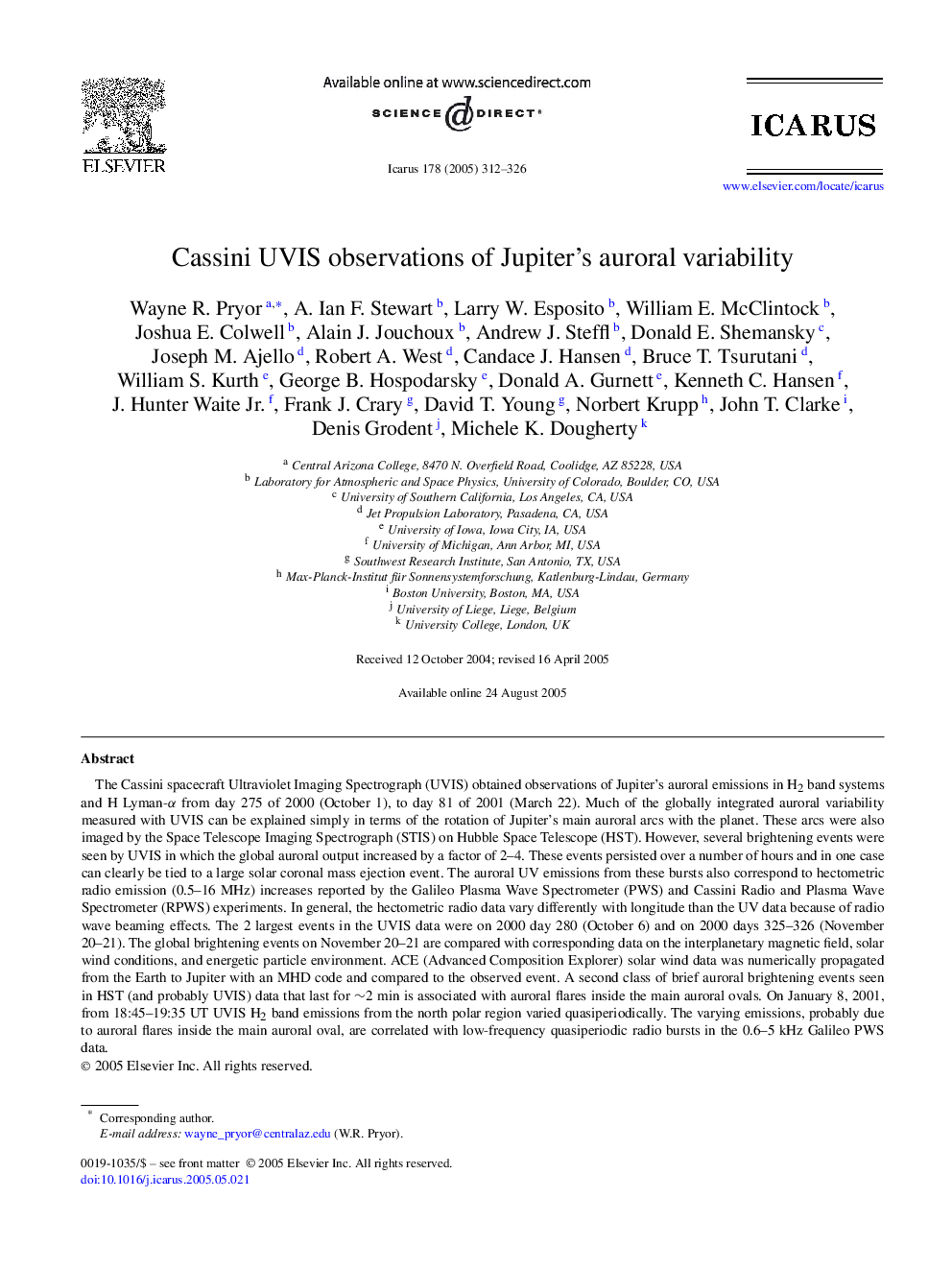| کد مقاله | کد نشریه | سال انتشار | مقاله انگلیسی | نسخه تمام متن |
|---|---|---|---|---|
| 10701829 | 1021219 | 2005 | 15 صفحه PDF | دانلود رایگان |
عنوان انگلیسی مقاله ISI
Cassini UVIS observations of Jupiter's auroral variability
دانلود مقاله + سفارش ترجمه
دانلود مقاله ISI انگلیسی
رایگان برای ایرانیان
موضوعات مرتبط
مهندسی و علوم پایه
علوم زمین و سیارات
علوم فضا و نجوم
پیش نمایش صفحه اول مقاله

چکیده انگلیسی
The Cassini spacecraft Ultraviolet Imaging Spectrograph (UVIS) obtained observations of Jupiter's auroral emissions in H2 band systems and H Lyman-α from day 275 of 2000 (October 1), to day 81 of 2001 (March 22). Much of the globally integrated auroral variability measured with UVIS can be explained simply in terms of the rotation of Jupiter's main auroral arcs with the planet. These arcs were also imaged by the Space Telescope Imaging Spectrograph (STIS) on Hubble Space Telescope (HST). However, several brightening events were seen by UVIS in which the global auroral output increased by a factor of 2-4. These events persisted over a number of hours and in one case can clearly be tied to a large solar coronal mass ejection event. The auroral UV emissions from these bursts also correspond to hectometric radio emission (0.5-16 MHz) increases reported by the Galileo Plasma Wave Spectrometer (PWS) and Cassini Radio and Plasma Wave Spectrometer (RPWS) experiments. In general, the hectometric radio data vary differently with longitude than the UV data because of radio wave beaming effects. The 2 largest events in the UVIS data were on 2000 day 280 (October 6) and on 2000 days 325-326 (November 20-21). The global brightening events on November 20-21 are compared with corresponding data on the interplanetary magnetic field, solar wind conditions, and energetic particle environment. ACE (Advanced Composition Explorer) solar wind data was numerically propagated from the Earth to Jupiter with an MHD code and compared to the observed event. A second class of brief auroral brightening events seen in HST (and probably UVIS) data that last for â¼2 min is associated with auroral flares inside the main auroral ovals. On January 8, 2001, from 18:45-19:35 UT UVIS H2 band emissions from the north polar region varied quasiperiodically. The varying emissions, probably due to auroral flares inside the main auroral oval, are correlated with low-frequency quasiperiodic radio bursts in the 0.6-5 kHz Galileo PWS data.
ناشر
Database: Elsevier - ScienceDirect (ساینس دایرکت)
Journal: Icarus - Volume 178, Issue 2, 15 November 2005, Pages 312-326
Journal: Icarus - Volume 178, Issue 2, 15 November 2005, Pages 312-326
نویسندگان
Wayne R. Pryor, A. Ian F. Stewart, Larry W. Esposito, William E. McClintock, Joshua E. Colwell, Alain J. Jouchoux, Andrew J. Steffl, Donald E. Shemansky, Joseph M. Ajello, Robert A. West, Candace J. Hansen, Bruce T. Tsurutani, William S. Kurth,